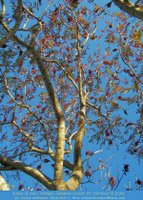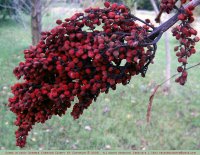More About Trees and Plants...
When we moved to Kentucky, my husband and I were very interested in planting native species of trees and shrubs in our yard to attract wildlife and birds.
I discovered a wonderful manual in our library -- Native Trees for Urban and Rural America* by Gary L. Hightshoe, and I studied it extensively. For many months, I checked it out, renewed it, returned it to the library, and went back again in a few days to check it out again.
As I pored over the Hightshoe manual and other tree and shrub books, I noticed that sumac was mentioned again and again as a tree with high wildlife value for everything from birds and squirrels to deer. I started talking about planting some sumac along the old roadbed on the south facing slope of our yard.
Finally, one winter day as the kids and I were driving home along a backroad, I saw some sumac with attractive red seedheads growing in the ditch. I pulled over and told Keely to jump out and get some seeds from them. She came back with a handful of seeds, and I put them in the freezer until spring and then planted them in peat pots.
I don't remember how many seeds came up, but I did successfully start and transplant four sumac trees in the dryest, rockiest area of our yard. I planted them together in a little clump, thinking they'd look natural like that.
We have two types of sumac that grow in this part of Kentucky. A year or two after I'd planted our sumac trees, I realized that Keely had plucked seeds of both types, and our little sumac clump had trees of both types. I wouldn't have done that, had I known, but apparently they were growing together in the ditch where we got the seeds. Oh well!
A dozen years later, I have become pretty well acquainted with sumac. I enjoy the way it looks, especially in fall and winter when it has its red seedheads. I hope it's helping the birds in winter, but where the trees are located, I can't really watch. The seeds are all gone by spring, but I don't know if they have been eaten or they just fall off.
 I don't like how the sumac constantly sends up shoots from its roots, making the lawn look messy. The shoots are easy enough to mow off, but they pop up all the time from May through August. (In fact, the easiest way to start a sumac tree is to dig up a root sucker rather than messing around with seeds.)
I don't like how the sumac constantly sends up shoots from its roots, making the lawn look messy. The shoots are easy enough to mow off, but they pop up all the time from May through August. (In fact, the easiest way to start a sumac tree is to dig up a root sucker rather than messing around with seeds.)The branches are extremely brittle, and it's easy to knock off a branch just by bending it a little too much with the lawn mower. They also break off in heavy snow or ice. This means that there are often sumac branches to drag off to the brush pile.
Would I plant it again? Oh, probably. I really do like its exotic look.
- - - - - - - - - - - - - - - - -
*Native Trees for Urban and Rural America* by Gary L. Hightshoe is no longer in print and I've never been able to locate a copy to buy. I eventually purchased a more comprehensive and even better manual by Gary L. Hightshoe: Native Trees, Shrubs, and Vines for Urban and Rural America. The copy I have was published by Van Nostrand Reinhold of New York in 1988 (ISBN 0-422-23274-8). I got it from Abebooks in like-new condition, and I paid $103 for it. It is the most expensive book I've ever bought for myself (except for textbooks), but I've never regretted it. It's a truly excellent reference.
Technorati tags:

4 comments:
I'm sure you probably know, but dried and crushed sumac berries can be used as a spice. I have never knowingly tasted it myself but it is widely used in various parts of the world.
No, I didn't know that, but it's very interesting and not too surprising.
The last I read on the sumac in these parts (which are all ways first to get a start in newly open areas) surprised me. The seed cone trees are the males and the ones without are the females (or is it the other way around?). I always seem to overlook the withouts? Sumac near water is dangerous and to be avoided as poison. Your most receint photos are especially nice, all the way up to "Autumn Blooms" 10/6. :)ken
Thanks, Kenneth. I hope you're continuing to feel a little better as the days go by. I have heard about poison sumac all my life and never have known what it looks like. Maybe that's it -- a type of sumac that grows near water???!
Post a Comment